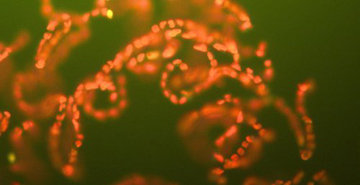The rosy glow of a baby’s cheeks is considered a sign of good health. In the oceans, though, a rosy glow can be a sign of poor health — both of the glowing organisms, and of the entire marine ecosystem.
 Phytoplankton naturally give off fluorescent light as they dissipate excess solar energy that they cannot consume through photosynthesis. Credit: Maria Vernet, Scripps Institution of Oceanography
Phytoplankton naturally give off fluorescent light as they dissipate excess solar energy that they cannot consume through photosynthesis. Credit: Maria Vernet, Scripps Institution of OceanographyThe glow comes from phytoplankton — tiny organisms that live in the top layers of the water. They’re the first link in the marine food chain — they’re eaten by larger organisms, which in turn are eaten by even bigger organisms, and so on. Phytoplankton also absorb carbon dioxide from the atmosphere, helping control Earth’s temperature. This combination makes them critical to life on the entire planet.
Phytoplankton live by combining carbon dioxide with sunlight, water, and nutrients in a process known as photosynthesis. But not all of the sunlight they receive goes into photosynthesis. Some of it causes the organisms to fluoresce, so they emit red light.
Orbiting satellites can detect this glow. When the phytoplankton are healthy and getting plenty of nutrients, they use most of the solar energy they receive for photosynthesis. But when they’re not getting enough, they use less of that solar energy for growing and more for glowing.
A key nutrient for phytoplankton is iron. Wind-blown dirt from the land brings much of the iron. But changing weather patterns caused by global climate change could alter the amount of iron they receive. The satellite observations can monitor the phytoplankton to make sure these tiny but important creatures are in good health — and don’t have a rosy glow.

